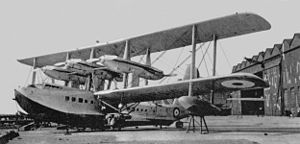Short Sarafand
| S.14 Sarafand | |
|---|---|

| |
| The prototype and only Sarafand at Felixstowe in 1932. | |
| Role | Flying boat |
| National origin | United Kingdom |
| Manufacturer | Short Brothers |
| First flight | 30 June 1932 |
| Retired | 1936 |
| Status | Prototype |
| Primary user | Royal Air Force |
| Number built | 1 |
The Short S.14 Sarafand was a British biplane flying boat built by Short Brothers. It was planned as a general reconnaissance aircraft for military service. When it was built in 1932 it was the largest aeroplane in the United Kingdom.
The Sarafand was first proposed by
Design
The Sarafand was a six-engined biplane flying boat with equal span wings.
Operational history
The Sarafand prototype was built at No. 3 Shop at Rochester, but the shop did not have enough height to fit the upper wing.
Operators
Specifications
Data from The Short "Sarafand" [6]
General characteristics
- Crew: 9 (2 pilots, navigator, radio operator, engineer, four gunners)
- Length: 89 ft 5 in (27.25 m)
- Wingspan: 120 ft 0 in (36.58 m)
- Height: 30 ft 4 in (9.25 m)
- Wing area: 3,460 sq ft (321 m2)
- Empty weight: 44,753 lb (20,300 kg)
- Gross weight: 70,000 lb (31,751 kg)
- Powerplant: 6 × Rolls-Royce Buzzard V12 engine in three tractor/pusher pairs, 850 hp (630 kW) each
Performance
- Maximum speed: 150 mph (240 km/h, 130 kn)
- Range: 1,450 mi (2,330 km, 1,260 nmi)
- Service ceiling: 13,000 ft (4,000 m)
- Rate of climb: 750 ft/min (3.8 m/s)
Armament
- Guns: Four 0.303 in Lewis machine guns mounted on Scarff rings; provision was made for a 1½-pounder (37 mm) gun to be fitted in the bow.
See also
Related development
Aircraft of comparable role, configuration, and era
References
- "The Short "Sarafand"". Flight. 13 June 1935. pp. 631–634.
- Barnes, Christoper Henry (1967). Shorts Aircraft since 1900. London: Putnam.
- Barnes, C.H.; James D.N. (1989). Shorts Aircraft since 1900. London: Putnam. ISBN 0-85177-819-4.
